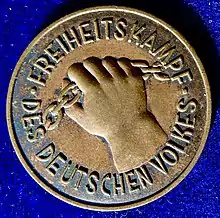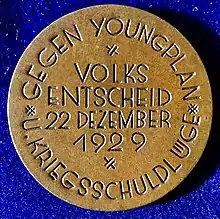1929 German referendum
A referendum was held in Germany on 22 December 1929.[1] It was a failed attempt to introduce a 'Law against the Enslavement of the German People'. The legislation, proposed by German nationalists, would formally renounce the Treaty of Versailles and make it a criminal offence for German officials to co-operate in the collecting of reparations. Although it was approved by 94.5% of those who voted, voter turnout was just 14.9%, well below the 50% necessary for it to pass.[2]
Background
Throughout 1929 Germany and the Entente worked on achieving a final settlement on the issue of German war debts. The proposed final settlement, known as the Young Plan, was considered relatively favourable to Germany. The Young Plan allowed for the release of all securities by the Allies and the removal of creditors' financial and economic control. In addition to this loosening of the economic burden of Versailles, France also agreed to evacuate the Rhineland in 1930, five years ahead of schedule. Although the Young Plan was certainly more advantageous to Germany than the original Treaty of Versailles, many German nationalists opposed it. They believed that accepting the Young Plan meant accepting Versailles. It meant confessing to the 'war guilt clause', which had not been modified under the Young Plan.[3] More practically they also believed that favourable settlements such as this undermined the will of the German people to defeat Versailles.[4]
Road to Referendum


Opposition to the Young Plan was led by nationalist politician and media baron, Alfred Hugenberg. He set up a league of many right-wing organisations to campaign together against the Plan. These organisations included the German National People's Party (DNVP), the Pan-German League, Der Stahlhelm and the National Socialist German Workers' Party (Nazi Party).[4] This last choice was surprising as that party's violent tactics and anti-capitalist rhetoric had made it anathema to the mainstream right. Yet Hugenberg admired the Nazis' dynamism and youthful enthusiasm and hoped to use them as a 'drum' in the campaign against the Young Plan.[4] The right-wing league proposed a new 'Freedom Law' as an alternative to the Young Plan. The proposed 'Freedom Law' renounced the 'war guilt clause' and the occupation of former German territories.[5] The proposed law renounced reparations and made it a criminal offence for any official to co-operate with their collection.[6]
The centre-left, centre and centre-right parties all supported the Young Plan as a step in restoring Germany's position in international affairs. As such, the 'Freedom Law' had little support in the Reichstag. When finally proposed there the bill was defeated by a 318-82 margin. The right hoped that the public would be more sympathetic. Enough signatures expressing support for the proposition were gathered to force a referendum on the issue under Article 73 of the Weimar Constitution. The fact that a sufficient number of signatures were gathered to cause a referendum surprised observers.[7]
Results
| Choice | Votes | % |
|---|---|---|
| For | 5,838,890 | 94.5 |
| Against | 338,195 | 5.5 |
| Invalid/blank votes | 131,493 | – |
| Total | 6,308,578 | 100 |
| Registered voters/turnout | 42,323,473 | 14.9 |
| Source: Nohlen & Stöver | ||
Aftermath
The referendum was very favourable to the Nazi Party and, as such, is considered to be an important event in German history. Exposure in Hugenberg's widely read newspapers gave the Nazis free publicity and party leader Adolf Hitler became a household name in Germany.[8] In addition to this, campaigning with the mainstream right-wing parties gave Hitler a credibility he had lacked before.[8] The dynamism and youthful enthusiasm of the Nazis which had appealed to Hugenberg appealed to voters too. In December 1929, the Nazis gained 11% of the vote in Thuringia and made gains in other states.[9]
In March 1930 the Reichstag ratified the Young Plan.
References
- Dieter Nohlen & Philip Stöver (2010) Elections in Europe: A data handbook, p762 ISBN 978-3-8329-5609-7
- Nohlen & Stöver, p770
- Erich Eyck, (1964), A History of the Weimar Republic, Volume II: From the Locarno Conference to Hiter's Seizure of Power, translated by Hanson, Harlan P. and Waite, Robert G.C, London: Oxford University Press, p. 220.
- A.J. Nicholls, (2000), Weimar and the Rise of Hitler, London: MacMillan Press, Ltd, p. 137.
- Eyck (1964), pp. 220-1.
- Eyck (1964), p. 221.
- Hans Mommsen, (1996), The Rise and Fall of Weimar Democracy, Chapel Hill: University of North Carolina Press, p. 280.
- Nicholls (2000), p. 138.
- Eberhard Kolb (1988), The Weimar Republic, New York: Routledge, p. 105.
Bibliography
- Eyck, Erich, (1964), A History of the Weimar Republic, Volume II: From the Locarno Conference to Hiter's Seizure of Power, translated by Hanson, Harlan P. and Waite, Robert G.C, London: Oxford University Press.
- Kolb, Eberhard, (1988), The Weimar Republic, New York: Routledge.
- Mommsen, Hans, (1996), The Rise and Fall of Weimar Democracy, Chapel Hill: University of North Carolina Press.
- Nicholls, A.J, (2000), Weimar and the Rise of Hitler, London: MacMillan Press, Ltd.